原标题:肠道中游离和微胶囊化包被中链脂肪酸的浓度对仔猪消化道中胃内微生物菌群和细菌代谢产物的影响
Intestinal concentrations of free and encapsulated dietary medium-chain fatty acids and effects on gastric microbial ecology and bacterial metabolic products in the digestive tract of piglets
作者:Ju¨rgen Zentek*, Susanne Buchheit-Renko, Klaus Ma¨nner, Robert Pieper and Wilfried Vahjen
Institute of Animal Nutrition, Department of Veterinary Medicine, Freie Universita¨t Berlin,
Berlin, Germany
来源:Archives of Animal Nutrition Vol. 66, No. 1, February 2012, 14–26
翻译:肠动力研究院 梁琦
【摘要】本文探究了日粮低浓度的游离和微胶囊化包被的中链脂肪酸(MCFA)对断奶仔猪胃肠道(GIT)中食糜的MCFA浓度、胃内微生物菌群以及胃肠道内细菌代谢产物的影响。断奶后开始试验,共36头断奶仔猪,分成3个组(每组2个重复),实验分组如下:对照组,饲喂对照日粮;MCFA组,对照日粮基础上添加0.3%中链脂肪酸(25%辛酸,25%癸酸,30%SiO2和20%芳香物质);MCFAc组:对照日粮基础上添加微囊化包被的0.255%的中链脂肪酸(25.4%辛酸和25.4%癸酸由37%SiO2,11.8%植物脂肪,0.4%向日葵卵磷脂包被)。4周后(26-28天),将这批仔猪安乐死,并收集胃和GIT不同部分(近端,中端和远端空肠;盲肠)的食糜展开分析。实验结果显示,与对照组相比,饲喂MCFA和MCFAc的仔猪的胃内辛酸(p<0.001)和癸酸(p= 0.001)的浓度显著更高。无论是否包被,两种酸的浓度都会沿着GIT迅速下降,但与对照组相比,MCFA组和MCFAc组仔猪的GIT中辛酸和癸酸浓度趋于更高。微生物菌群分析实验中,研究人员发现,与对照组相比,喂食MCFAc将显著增加仔猪的胃内容物中真细菌(p= 0.001),肠杆菌科(p<0.001),梭菌属I(p= 0.001)和IV(p= 0.019),约氏乳杆菌(p<0.001),乳酸乳杆菌(p= 0.001)的含量,饲喂MCFA也出现了类似的趋势。最后,对细菌代谢产物分析发现,与对照组和MCFA组仔猪相比,MCFAc组仔猪的远端空肠中丙酸浓度显著较低(P=0.045),乙酸浓度更高;然而与对照组仔猪相比,MCFA组和MCFAc组仔猪的正丁酸和异戊酸浓度较低。三组实验中,GIT中乳酸浓度没有发生显著变化,相比于对照组,MCFA和MCFAc组仔猪的远端空肠的铵浓度则显著增加(p< 0.001)。总之,中链脂肪酸能够影响胃内容物的微生物生态学参数和小肠的细菌代谢产物。在低浓度下,中链脂肪酸可被视为断奶仔猪胃内微生物群的调节剂。
【关键词】吸收;消化道;中链脂肪酸;微生物生态学;仔猪
以下是实验中相关图表
表1:仔猪日粮的组成及营养成分(以饲喂为基础)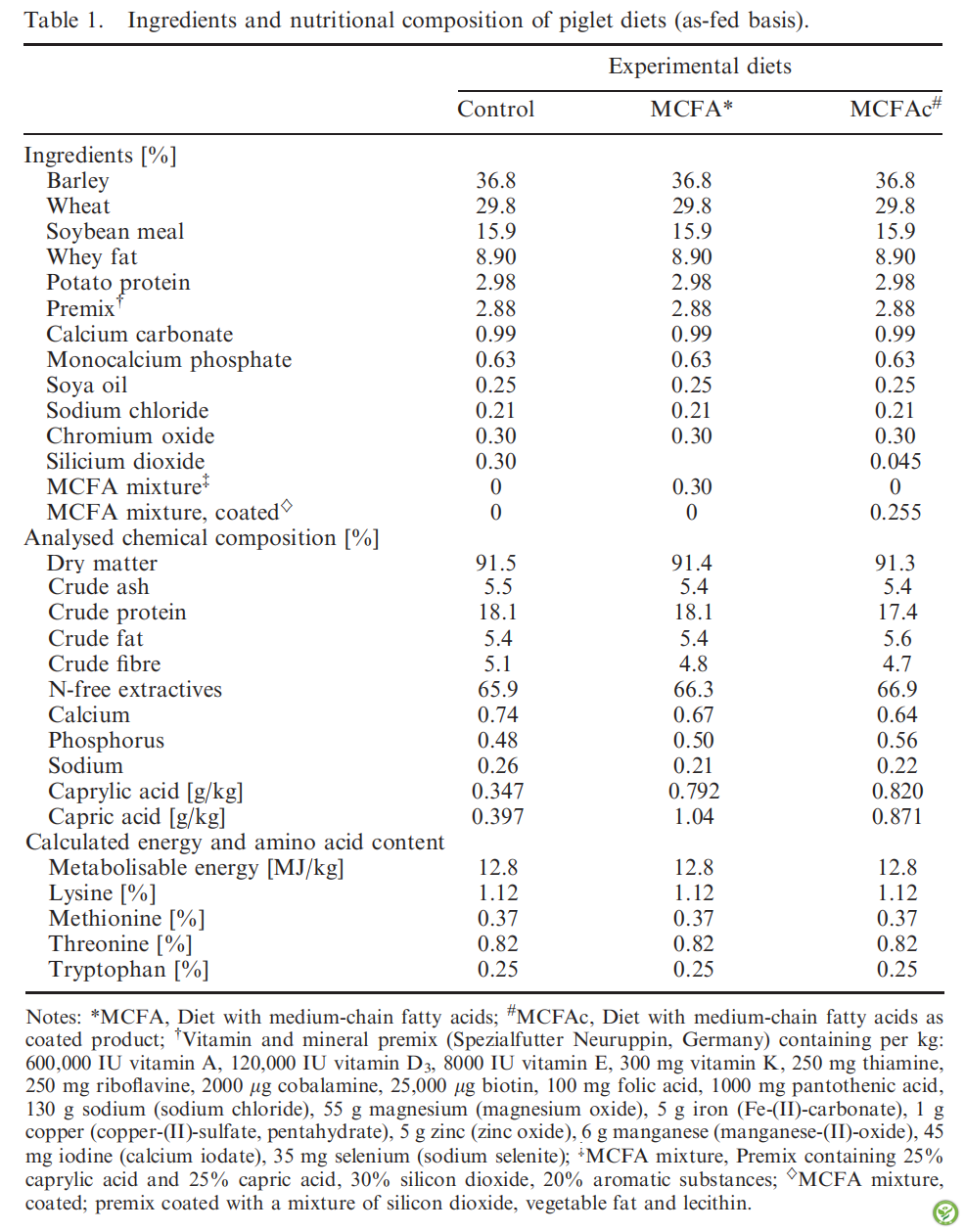
表2:喂食实验日粮的仔猪的生产性能
表3:喂食实验日粮的仔猪的胃肠道食糜中辛酸(C8:0)和癸酸(C10:0)的浓度(mmol/kg)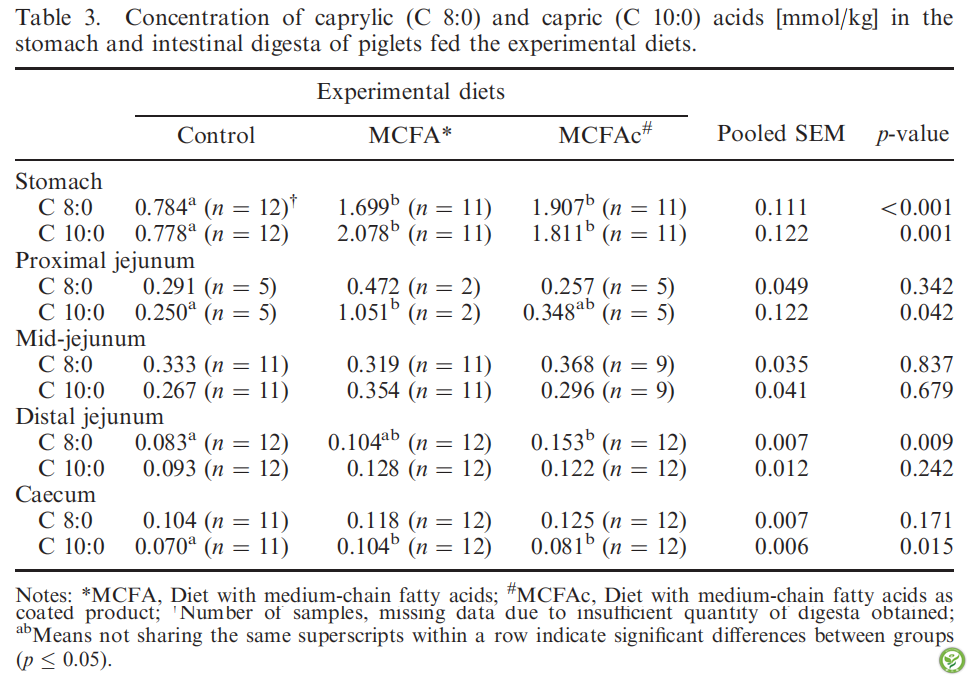
表4:饲喂实验日粮的仔猪的胃内容物中细菌含量(log10/g)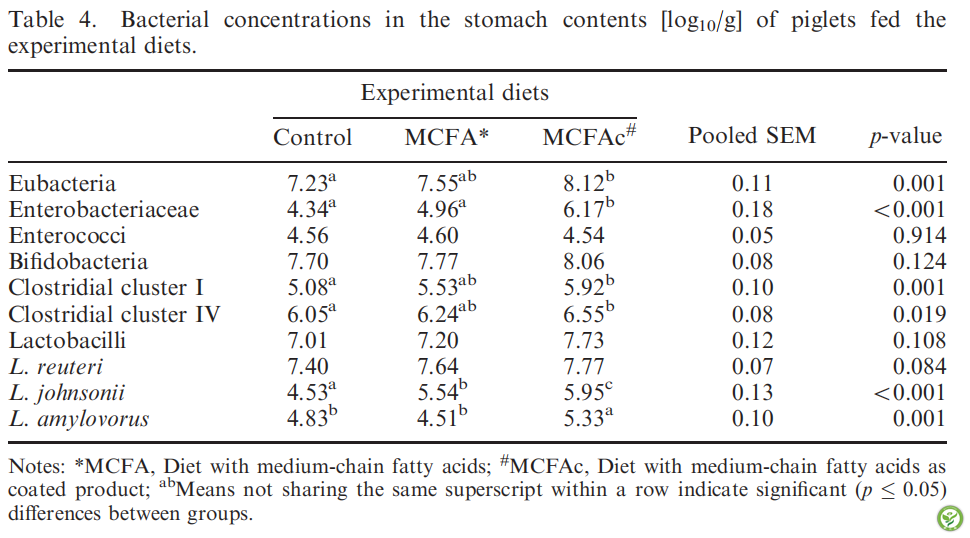
表5:饲喂实验日粮的仔猪的GIT的各种位置的食糜中短链脂肪酸的总浓度和相对比例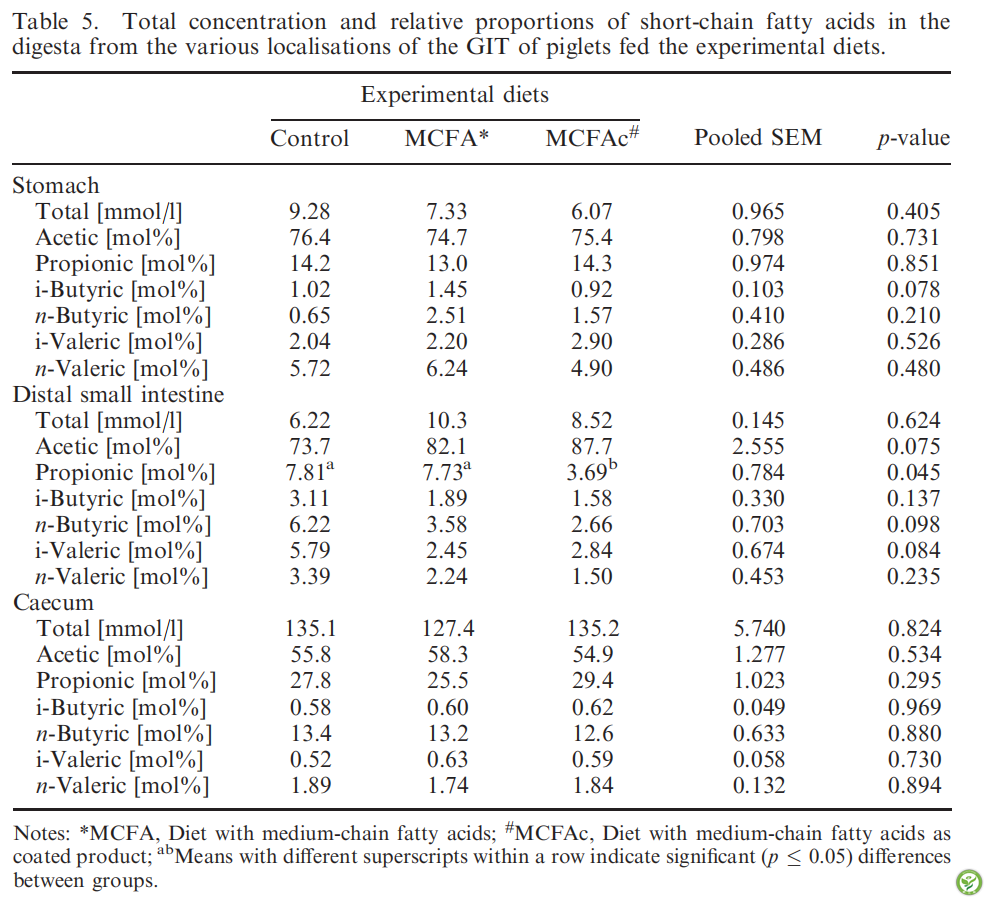
表6:喂食实验日粮的仔猪GIT的各种位置的食糜样品中L-和D-乳酸和铵的浓度[mmol / L]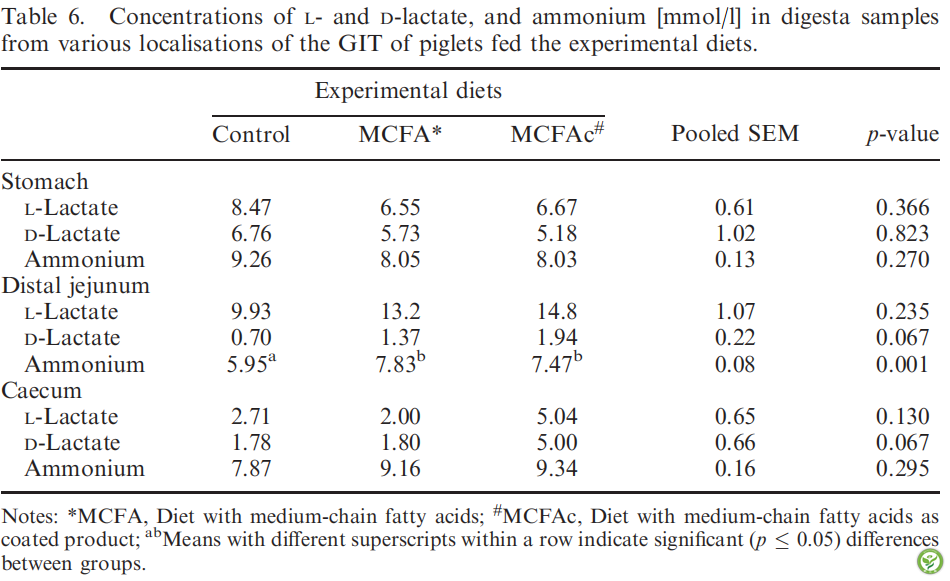
Conclusion
与游离形式的中链脂肪酸(MCFA)相比,选择微胶囊包被技术并没有增加小肠远端部分MCFA的浓度,所以不难排除植物脂肪与卵磷脂的组合物用于此项研究。由于小肠中的低浓度的MCFA和环境条件,MCFA的抗菌潜力似乎有限,除非在日粮中添加高浓度的MCFA。因此,它们的使用可能更倾向于影响胃的微生物生态学。
Abstract
The influence of low dietary levels of free and encapsulated medium-chain fattyacids on their concentrations in the digesta, the gastric microbial ecology and bacterial metabolic products in the gastrointestinal tract (GIT) in weaned piglets was studied. Starting after weaning, 36 piglets were fed a diet without (Control) or with medium-chain fatty acids uncoated (MCFA) or coated with vegetable fat and lecithin (MCFAc). After 4 weeks, the animals were killed, and digesta from the stomach and different sections of the GIT were collected. The concentrations of caprylic (p<0.001) and capric (p=0.001) acids were higher in the stomachs of piglets fed diets MCFA and MCFAc compared to the Control group. The concentrations dropped rapidly along the GIT, regardless of encapsulation, and tended to be higher in groups MCFA and MCFAc compared to the Control. Compared to the Control group, ingestion of diet MCFAc led to an increase in the number of eubacteria (p=0.001), enterobacteriaceae (p< 0.001), clostridial clusters I (p=0.001) and IV (p= 0.019), Lactobacillus johnsonii (p<0.001) and Lactobacillus amylovorus (p=0.001) in gastric contents. A similar trend was seen with diet MCFA. Relative concentrations of short-chain fatty acids were characterised by lower propionic acid levels (p=0.045), numerically (p<0.1) higher acetic, lower n-butyric and i-valeric acid concentrations in the small intestine. Lactic acid concentrations were not significantly changed in the GIT, but ammonia concentrations increased (p<0.001) in the distal small intestine in the MCFA and MCFAc groups. In conclusion, medium-chain fatty acids affected microbial ecology parameters in the gastric contents and bacterial metabolites in the small intestine. At low dietary levels, medium-chain fatty acids may be
regarded as modulators of the gastric microbiota in weaned piglets.
Keywords: absorption; digestive tract; medium-chain fatty acids; microbial ecology; piglets
Conclusion
The selected coating technology did not increase the concentrations of medium-chain fatty acids in the distal part of the small intestine compared to the free form, precluding the combination of vegetable fat and lecithin from being used for this purpose. Due to the low concentrations and the milieu conditions in the small intestine, the antibacterial potential of medium-chain fatty acids seems limited unless high dietary concentrations are present. Their use might therefore rather be targeted at influencing the gastric bacterial ecology
如您需原文,请联系本文作者和出版方,或请垂询肠动力研究院。本网站发布的所有资料将尽最大可能注明出处、作者及日期,如无意中侵犯了您的知识产权,请来信及时告知,我们将立即予以删除。
All information released by the WeChat Official Account will do its best to indicate the source, author and date. If we inadvertently infringe on your intellectual property, please inform us in time and we will delete it immediately.





